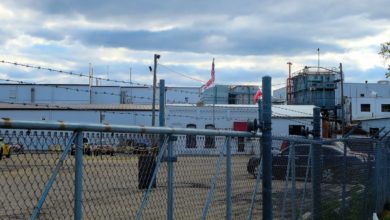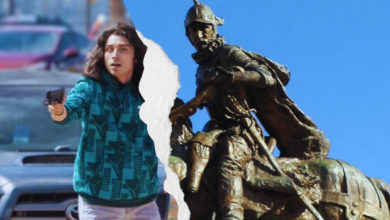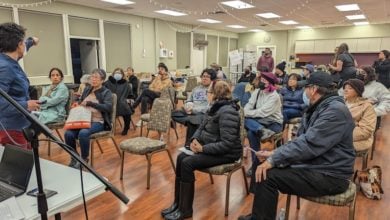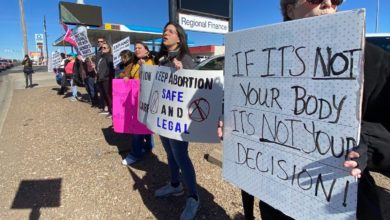As the morning fog lifted in the early hours of July 14 revealing a breathtaking mountainous scenery, the annual Church Rock Uranium Legacy Remembrance and Action Day walk began along the Red Water Pond road in Church Rock where one of the most disastrous uranium spills in the world took place. Protesters used unified resounding chants such as “No uranium mining,” and “Keep uranium in the ground!” The juxtaposition of the picturesque beauty of Church Rock and the thought of its land, water and air tainted with radioactive contamination is both haunting and rage-inducing.
Church Rock is located outside Gallup, New Mexico, on the Navajo Nation Reservation. It is the largest Indigenous reservation in the United States, about the size of West Virginia. It is also home to the largest radioactive spill in U.S.history and the third-largest in the world. On July 16, 1979, the United Nuclear Corporation released over 1,000 tons of solid radioactive mill waste along with 93 million gallons of radioactive tailings into the Puerco River. This devastating disaster has never received much national attention and almost no positive response to resolving the problems.
What made the problem so devastating was that those living near the river—mostly Navajos—-were not immediately notified and many remained completely unaware of the problems. People continued using the contaminated water for their own use and as a resource of irrigation their crops and for their livestock. Thousands of residents lost access to clean water.
United Nuclear later acknowledged that a dam on the reservation near Church Rock was constructed on an unstable geological site. The site in fact had been designated as unstable by federal and state inspections, but it was still built and allowed to operate. When cracks in the dam appeared, they were fixed with a temporary solution. Two years later the dam was breached which led to the massive spill. United Nuclear quickly claimed the problem was now the responsibility of the New Mexico state government. New Mexico claimed it had neither the money nor the resources to clean up the problem.
The Navajo Nation made repeated requests to have the site declared as a federal disaster area, but the state has denied the request and thereby limited the aid provided to the affected communities.
he 1979 spill is not an isolated incident. Uranium mining on the Navajo reservation began in the 1940s and continued into the mid-1980s. During that period, federal officials estimate that private corporations mined over four million tons of uranium from the reservation. As a result, there are over 500 abandoned mines—250 of which were uranium mines many of which have contributed to ground water contamination. Studies that began in the 1950’s have demonstrated that Navajos have a significantly higher rate of cancer than the national average.
The annual Remembrance Day is organized by the Mutual Alliance for a Safe Environment, and includes a coalition of groups like the Red Water Pond Association and Post-71, Uranium Workers Committee.
Together with those directly affected by this disaster, the ANSWER Coalition of New Mexico participated in the commemoration of the 1979 spill in Church Rock to stand in solidarity with the local community as well as the greater Navajo Nation that continues to suffer devastating health, and ecological consequences.
hough a modest turnout this year, the annual three mile walk is symbolic of the relentless fight of the Dine peoples’ quest for justice for their families, relatives, and communities. Many protesters picked up ANSWER signs that read, “Mining companies, hands off Native lan!,” “Denuclearize the U.S.,” and “They make the nukes, we pay the price.”
The walk culminated near the site of the breached dam where people gathered to hear the stories and demands of the community. A member of the Red Water Pond Community Association and a founding member of the Commemoration Day walk said: “Back in 1979, there was almost no coverage of the break of the dam and the contamination of Red Water pond. We are still asking for clean up to this day after over four decades. Those affected by the Three Mile Island incident in Pennsylvania in the same year were already compensated immediately. Even if the clean up here happens, there are still unforeseen effects on our health and our environment. The mining company responsible wasn’t shut down until 1986, till eight years after the spill.”
The mining company walked away with billions of dollars, and dusted its hands off of any responsibility for clean up, and the capitalist U.S. government allowed it to do so with impunity.
ANSWER Coalition organizer, Paige Murphy, whose family has experienced the effects of the uranium spill since her grandparents’ time, engaged the crowd with these words: “What we are saying is, it’s enough! This is our home. This is a crisis and people are dying. The state says it doesn’t have any money for clean up, but the U.S. just approved a defense budget for over 700 billion dollars, there’s money there! There’s no reason why this clean up should be delayed. They say that the mining companies bring jobs, but we don’t want those jobs! We want clean, safe, sustainable, jobs. We don’t need these mining companies. We want them off the land, we want to seize their assets, and we want to use them for this clean up that’s long overdue.”
She was followed by Elouise Brown, a Navajo activist and president of the Dooda (NO) Desert Rock Organization dedicated to stopping the Desert Rock Energy Project on Navajo land. Brown was interviewed by ANSWER while in Church Rock. She attends the Remembrance Day every year, and this year she was walking in honor of her late father Henry Dixon, who was a uranium mill operator for many years in Ambrosia Lake, New Mexico. She reported that workers were not told that working with uranium could be dangerous to their lives. Her father was exposed to radiation and died at an early age from two different types of brain cancer.
Brown also imparted a message of multinational solidarity among all exploited people. In her own words: “Everyday I am here to protect Mother Earth and Father Sky, and their children which is us. Doesn’t matter what color people are, we need to take care of our health. I say no more uranium mining, not only on the Navajo reservation but anywhere else. Uranium mining’s going to hurt everybody. Uranium is not going to say ‘this person is of a different color, so they are exempt.’”
Following the walk, ANSWER organizer and PSL member, Marcus Nells, whose family grew up in the mid-region of the Navajo Nation reservation, addressed Red Water Pond community members, activists, and supporters with a speech in which he drew parallels between Church Rock and his hometown, where contaminants released by mining and extraction companies leaked into aquifers. He went on to say, “My mother grew up playing on these leftover uranium deposits during her childhood. The U.S. military currently has over 6,000 nuclear weapons stored near and in Albuquerque. Now, Holtec wants to bring all the nuclear waste extracted across the country from communities like to this one to New Mexico. This state has been deemed a waste land by so many corporations that wish to exploit our labor, and our resources here.”
The Native nations’ fight against mining and extraction companies must be understood for what it is: the on-going resistance to the continued legacy of colonization and national oppression of indigenous peoples on their own homeland. The imperialist U.S. government has no respect for the self-determination and sovereignty of Native nations.
We need a people’s movement to shut down this system, and create a new one; one in which the people, rather than profit-seeking capitalist parasites, can have control over their land, water, and air. United we have the power and the skills to reorganize society in a sustainable way. We need a socialist system that utilizes the world’s resources to sustain and improve life for everyone on the planet, that puts life over profits for a few.





